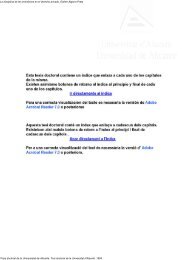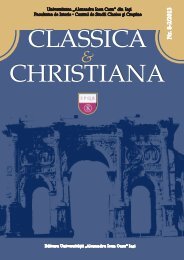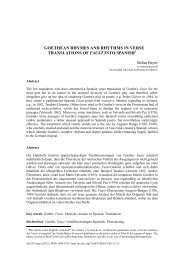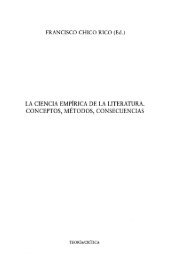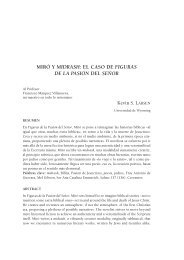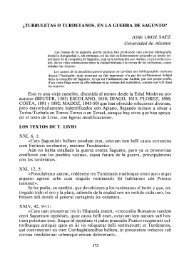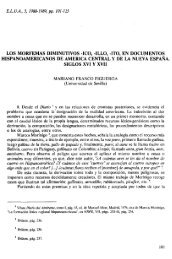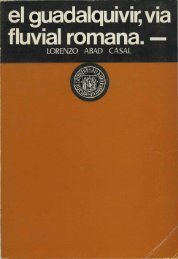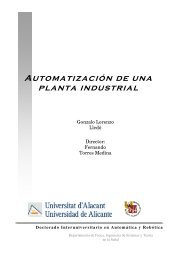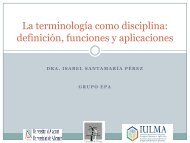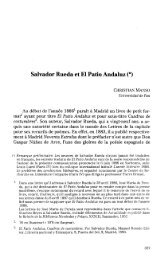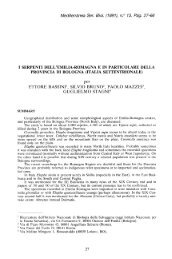- Page 1 and 2:
Estudio de los procesos de reticula
- Page 3 and 4:
Deseo expresar mi más sincera grat
- Page 5 and 6:
Índices Índice general 1. Introdu
- Page 7 and 8:
2.2.1.1. Métodos de análisis cin
- Page 9 and 10:
6.2.2.4. Agente espumante. 263 6.2.
- Page 11 and 12:
Índice de figuras Introducción Fi
- Page 13 and 14:
Antecedentes Figura 2.1. (A) Degrad
- Page 15 and 16:
Figura 2.29. Cálculo de constantes
- Page 17 and 18:
Figura 5.18. TGA de las mezclas bin
- Page 19 and 20:
Figura 5.40. Relación entre el cal
- Page 21 and 22:
Figura 6.12. Curvas de TGA experime
- Page 23 and 24:
Figura 6.29. Contribución asociada
- Page 25 and 26:
Figura 6.47. Termogramas (experimen
- Page 27 and 28:
Figura 6.62. Variación de los par
- Page 29 and 30:
Índice de tablas Introducción Tab
- Page 31 and 32:
Tabla 5.4. Temperaturas de pico de
- Page 33 and 34:
Glosario de términos Abreviatura D
- Page 35 and 36:
Abreviatura Descripción N Número
- Page 37 and 38:
XXXIII
- Page 39 and 40:
Por otra parte, en el grupo de inve
- Page 41 and 42:
4 Introducción Teflon ® , un plá
- Page 43 and 44:
6 Introducción 1.2.- Síntesis de
- Page 45 and 46:
8 Introducción 1.3.- División de
- Page 47 and 48:
10 Introducción 1.3.2.- División
- Page 49 and 50:
12 Introducción (i) Plásticos con
- Page 51 and 52:
14 Introducción 1.5.1.1.- Propieda
- Page 53 and 54:
16 Introducción Figura 1.9. Depend
- Page 55 and 56:
18 Introducción propilen dieno) (G
- Page 57 and 58:
20 Introducción (ii).- El mercado
- Page 59 and 60:
22 Introducción El copolímero EVA
- Page 61 and 62:
24 Introducción Figura 1.12. Esque
- Page 63 and 64:
26 Introducción Tabla 1.2. Influen
- Page 65 and 66:
28 Introducción (depósitos de car
- Page 67 and 68:
30 Introducción 1.5.3.1.- Azobis(i
- Page 69 and 70:
32 Introducción 1.5.3.3.- Azodicar
- Page 71 and 72:
(i) 34 Introducción (ii) (iii) (iv
- Page 73 and 74:
36 Introducción 1.5.3.4.- Bencenos
- Page 75 and 76:
38 Introducción bencensulfonilhidr
- Page 77 and 78:
40 Introducción Las reacciones de
- Page 79 and 80:
(A) (B) (C) (D) (E) 42 Introducció
- Page 81 and 82:
44 Introducción 1.6.- Técnicas de
- Page 83 and 84:
46 Introducción Figura 1.24. Tipos
- Page 85 and 86:
48 Introducción aparecen efectos e
- Page 87 and 88:
50 Introducción calentada hasta un
- Page 89 and 90:
52 Introducción Los aspectos hist
- Page 91 and 92:
54 Introducción Asolido (1) ↔ Bs
- Page 93 and 94:
56 Introducción tanto, la forma de
- Page 95 and 96:
58 Antecedentes 2.1.1.- Entrecruzam
- Page 97 and 98:
60 Antecedentes Figura 2.1. (A) Deg
- Page 99 and 100:
62 Antecedentes Martínez y col. (1
- Page 101 and 102:
64 Antecedentes Figura 2.5. DSC de
- Page 103 and 104:
66 Antecedentes Figura 2.7. Conteni
- Page 105 and 106:
68 Antecedentes Tabla 2.2. Efecto d
- Page 107 and 108:
70 Antecedentes presentan una eleva
- Page 109 and 110:
72 Antecedentes Rodríguez-Pérez y
- Page 111 and 112:
74 Antecedentes Figura 2.11. Expans
- Page 113 and 114:
76 Antecedentes la temperatura y co
- Page 115 and 116:
78 Antecedentes Tabla 2.5. Efecto d
- Page 117 and 118:
80 Antecedentes EVA/Bu2SnO, el mód
- Page 119 and 120:
82 Antecedentes Tabla 2.6. Propieda
- Page 121 and 122:
84 Antecedentes estabilidad morfol
- Page 123 and 124:
86 Antecedentes una razón en peso
- Page 125 and 126:
88 Antecedentes Figura 2.17. Propie
- Page 127 and 128:
90 Antecedentes 2.1.4.- Espumado de
- Page 129 and 130:
92 Antecedentes En esta figura se p
- Page 131 and 132:
94 Antecedentes aumenta la concentr
- Page 133 and 134:
96 Antecedentes capaz de representa
- Page 135 and 136:
98 Antecedentes cuyo caso se está
- Page 137 and 138:
100 Antecedentes Tabla 2.12. Temper
- Page 139 and 140:
102 Antecedentes Conociendo los val
- Page 141 and 142:
104 Antecedentes proporcionan una l
- Page 143 and 144:
106 Antecedentes ver que se llegan
- Page 145 and 146:
108 Antecedentes muestra que descom
- Page 147 and 148:
110 Antecedentes W/W 0 1,1 1 0,9 0,
- Page 149 and 150:
112 Antecedentes 2.2.2.- Estudios c
- Page 151 and 152:
114 Antecedentes Figura 2.27. Curva
- Page 153 and 154:
116 Antecedentes La Figura 2.28 mue
- Page 155 and 156:
118 Antecedentes Figura 2.29. Cálc
- Page 157 and 158:
120 Antecedentes Figura 2.30. (A) C
- Page 159 and 160:
122 Antecedentes (ii) Método de El
- Page 161 and 162:
3.- Objetivos y plan de trabajo. Lo
- Page 163 and 164:
Objetivos y plan de trabajo 127 de
- Page 165 and 166:
130 Experimental conferir mejores p
- Page 167 and 168:
132 Experimental 4.1.4.- Agente esp
- Page 169 and 170:
134 Experimental 4.1.5.- Agente act
- Page 171 and 172:
136 Experimental 4.3.- Equipos empl
- Page 173 and 174:
138 Experimental Figura 4.3. Prensa
- Page 175 and 176:
140 Experimental Figura 4.5. Equipo
- Page 177 and 178:
142 Experimental 4.4.3.- Extracció
- Page 179 and 180: 144 Experimental 4.5.- Tratamiento
- Page 181 and 182: 146 Resultados y discusión: Análi
- Page 183 and 184: 148 Resultados y discusión: Análi
- Page 185 and 186: 150 Resultados y discusión: Análi
- Page 187 and 188: 152 Resultados y discusión: Análi
- Page 189 and 190: 154 Resultados y discusión: Análi
- Page 191 and 192: 156 Resultados y discusión: Análi
- Page 193 and 194: W/W 0 158 Resultados y discusión:
- Page 195 and 196: 160 Resultados y discusión: Análi
- Page 197 and 198: 162 Resultados y discusión: Análi
- Page 199 and 200: dQ/dT (J/gK) dQ/dT (J/gK) 3 2,5 2 1
- Page 201 and 202: dQ/dT (J/gK) dQ/dT (J/gK) 3 2,5 2 1
- Page 203 and 204: 168 Resultados y discusión: Análi
- Page 205 and 206: 170 Resultados y discusión: Análi
- Page 207 and 208: 172 Resultados y discusión: Análi
- Page 209 and 210: W/W 0 d(W/W 0)/dt 174 Resultados y
- Page 211 and 212: d(W/W 0)/dt W/W 0 176 Resultados y
- Page 213 and 214: 178 Resultados y discusión: Análi
- Page 215 and 216: 180 Resultados y discusión: Análi
- Page 217 and 218: 182 Resultados y discusión: Análi
- Page 219 and 220: 184 Resultados y discusión: Análi
- Page 221 and 222: 186 Resultados y discusión: Análi
- Page 223 and 224: 188 Resultados y discusión: Análi
- Page 225 and 226: 190 Resultados y discusión: Análi
- Page 227 and 228: 192 Resultados y discusión: Análi
- Page 229: dQ/dT (J/gK) dQ/dT (J/gK) 3 2,5 2 1
- Page 233 and 234: dQ/dT (J/gK) dQ/dT (J/gK) 3 2,5 2 1
- Page 235 and 236: 200 Resultados y discusión: Análi
- Page 237 and 238: d(W/W 0)/dt W/W 0 202 Resultados y
- Page 239 and 240: d(W/W 0)/dt W/W 0 204 Resultados y
- Page 241 and 242: d(W/W 0)/dt W/W 0 206 Resultados y
- Page 243 and 244: 208 Resultados y discusión: Análi
- Page 245 and 246: 210 Resultados y discusión: Análi
- Page 247 and 248: 212 Resultados y discusión: Análi
- Page 249 and 250: 214 Resultados y discusión: Análi
- Page 251 and 252: 216 Resultados y discusión: Análi
- Page 253 and 254: 218 Resultados y discusión: Análi
- Page 255 and 256: 220 Resultados y discusión: Análi
- Page 257 and 258: 222 Resultados y discusión: Análi
- Page 259 and 260: 224 Resultados y discusión: Análi
- Page 261 and 262: 226 Resultados y discusión: Análi
- Page 263 and 264: 228 Resultados y discusión: Análi
- Page 265 and 266: 230 Resultados y discusión: Análi
- Page 267 and 268: 232 Resultados y discusión: Análi
- Page 269 and 270: 234 Resultados y discusión: Análi
- Page 271 and 272: 236 Resultados y discusión: Análi
- Page 273 and 274: 238 Resultados y discusión: Análi
- Page 275 and 276: 240 Resultados y discusión: Análi
- Page 277 and 278: 242 Resultados y discusión: Análi
- Page 279 and 280: 244 Resultados y discusión: Análi
- Page 281 and 282:
246 Resultados y discusión: Análi
- Page 283 and 284:
Contribución Cp (J/gK) 1,1 1 0,9 0
- Page 285 and 286:
250 Resultados y discusión: Análi
- Page 287 and 288:
252 Resultados y discusión: Análi
- Page 289 and 290:
254 Resultados y discusión: Análi
- Page 291 and 292:
256 Resultados y discusión: Análi
- Page 293 and 294:
258 Resultados y discusión: Análi
- Page 295 and 296:
260 Resultados y discusión: Análi
- Page 297 and 298:
262 Resultados y discusión: Análi
- Page 299 and 300:
264 Resultados y discusión: Análi
- Page 301 and 302:
266 Resultados y discusión: Análi
- Page 303 and 304:
268 Resultados y discusión: Análi
- Page 305 and 306:
270 Resultados y discusión: Análi
- Page 307 and 308:
272 Resultados y discusión: Análi
- Page 309 and 310:
274 Resultados y discusión: Análi
- Page 311 and 312:
276 Resultados y discusión: Análi
- Page 313 and 314:
278 Resultados y discusión: Análi
- Page 315 and 316:
280 Resultados y discusión: Análi
- Page 317 and 318:
dQ/dT (J/gK) dQ/dT (J/gK) 4 3,5 3 2
- Page 319 and 320:
dQ/dT (J/gK) dQ/dT (J/gK) 3 2,5 2 1
- Page 321 and 322:
286 Resultados y discusión: Análi
- Page 323 and 324:
288 Resultados y discusión: Análi
- Page 325 and 326:
290 Resultados y discusión: Análi
- Page 327 and 328:
292 Resultados y discusión: Análi
- Page 329 and 330:
1,2 1 0,8 0,6 0,4 0,2 0 -0,2 -0,4 -
- Page 331 and 332:
296 Resultados y discusión: Análi
- Page 333 and 334:
Log kr,D1,EVA (min -1 ) -14,9 -15,0
- Page 335 and 336:
1,2 1 0,8 0,6 0,4 0,2 0 -0,2 -0,4 -
- Page 337 and 338:
302 Resultados y discusión: Análi
- Page 339 and 340:
304 Resultados y discusión: Análi
- Page 341 and 342:
306 Resultados y discusión: Análi
- Page 343 and 344:
Calor de reacción E6 (J/g) 2750 25
- Page 345 and 346:
310 Resultados y discusión: Análi
- Page 347 and 348:
312 Resultados y discusión: Análi
- Page 349 and 350:
314 Resultados y discusión: Análi
- Page 351 and 352:
316 Resultados y discusión: Análi
- Page 353 and 354:
318 Resultados y discusión: Análi
- Page 355 and 356:
dQ/dT (J/gK) dQ/dT (J/gK) 3 2,5 2 1
- Page 357 and 358:
320 Resultados y discusión: Análi
- Page 359 and 360:
dQ/dT (J/gK) dQ/dT (J/gK) 3,5 3 2,5
- Page 361 and 362:
dQ/dT (J/gK) dQ/dT (J/gK) 3 2,5 2 1
- Page 363 and 364:
326 Resultados y discusión: Análi
- Page 365 and 366:
328 Resultados y discusión: Análi
- Page 367 and 368:
330 Resultados y discusión: Análi
- Page 369 and 370:
332 Resultados y discusión: Análi
- Page 371 and 372:
334 Resultados y discusión: Análi
- Page 373 and 374:
336 Resultados y discusión: Análi
- Page 375 and 376:
338 Resultados y discusión: Análi
- Page 377 and 378:
340 Resultados y discusión: Análi
- Page 379 and 380:
342 Resultados y discusión: Análi
- Page 381 and 382:
344 Resultados y discusión: Análi
- Page 383 and 384:
346 Resultados y discusión: Análi
- Page 385 and 386:
Contribución Cp (J/gK) Contribuci
- Page 387 and 388:
350 Resultados y discusión: Análi
- Page 389 and 390:
Contribución Cp (J/gK) 1,4 1,2 1 3
- Page 391 and 392:
354 Resultados y discusión: Análi
- Page 393 and 394:
1,2 1 0,8 0,6 0,4 0,2 0 -0,2 -0,4 -
- Page 395 and 396:
358 Resultados y discusión: Análi
- Page 397 and 398:
360 Resultados y discusión: Análi
- Page 399 and 400:
362 Conclusiones espumante (ADC) lo
- Page 401 and 402:
364 Conclusiones largo de dichos pr
- Page 403 and 404:
366 Conclusiones aditivos. Sin emba
- Page 405 and 406:
368 Bibliografía Beltrán, M., Mar
- Page 407 and 408:
370 Bibliografía Elliot, R., Rubbe
- Page 409 and 410:
372 Bibliografía Kovacevic, V., Lu
- Page 411 and 412:
374 Bibliografía Norma UNE 53 200
- Page 413 and 414:
376 Bibliografía Teyssié, Ph., Ma
- Page 415 and 416:
378 Apéndice A Tabla A.1.- Datos p
- Page 417 and 418:
380 Apéndice A Tabla A.3. Temperat
- Page 419 and 420:
382 Apéndice A Tabla A.5. Temperat
- Page 421 and 422:
384 Apéndice A Tabla A.7. Datos pr
- Page 423 and 424:
386 Apéndice A Tabla A.9. Datos pr
- Page 425 and 426:
Apéndice B. Apéndice B 389 En el
- Page 427 and 428:
Apéndice B 391 Tabla B.2. Parámet
- Page 429 and 430:
Apéndice B 393 Tabla B.4.- Paráme
- Page 431 and 432:
Apéndice B 395 Tabla B.6. Parámet
- Page 433 and 434:
Apéndice B 397 Tabla B.8. Parámet
- Page 435 and 436:
Apéndice B 399 Tabla B.10. Paráme
- Page 437 and 438:
Apéndice B 401 Tabla B.12. Paráme
- Page 439 and 440:
Apéndice B 403 Tabla B.14. Paráme
- Page 441 and 442:
Apéndice B 405 Tabla B.16. Paráme
- Page 443 and 444:
Apéndice B 407 Tabla B.18. Paráme
- Page 445 and 446:
Apéndice B 409 Tabla B.20. Paráme
- Page 447 and 448:
Apéndice B 411 Tabla B.22. Paráme
- Page 449 and 450:
Apéndice C. Apéndice C 413 En el
- Page 451 and 452:
Apéndice C 415 Tabla C.3. Parámet
- Page 453 and 454:
Apéndice C 417 Tabla C.5. Parámet
- Page 455 and 456:
Apéndice C 419 Tabla C.7. Parámet
- Page 457 and 458:
Apéndice C 421 Tabla C.9. Parámet
- Page 459 and 460:
Apéndice C 423 Tabla C.11. Paráme
- Page 461 and 462:
Apéndice C 425 Tabla C.13. Paráme
- Page 463 and 464:
Apéndice C 427 Tabla C.15. Paráme
- Page 465 and 466:
430 Apéndice D D.1 - Desarrollo de
- Page 467 and 468:
432 Apéndice D D.2 - Desarrollo de
- Page 469 and 470:
434 Apéndice D (D.3.5) (D.3.6) (D.
- Page 471 and 472:
436 Apéndice D D.5 - Desarrollo de
- Page 473 and 474:
438 Apéndice D D.7 - Desarrollo de
- Page 475 and 476:
440 Apéndice D D.9 - Desarrollo de
- Page 477 and 478:
442 Apéndice D donde φ, η y (1-
- Page 479 and 480:
444 Apéndice D donde φ, η, λ,
- Page 481 and 482:
446 Apéndice E E.1 - Desarrollo de
- Page 483 and 484:
448 Apéndice E E.2 - Desarrollo de
- Page 485 and 486:
450 Apéndice E E.3 - Desarrollo de
- Page 487 and 488:
452 Apéndice E E.4 - Desarrollo de
- Page 489 and 490:
454 Apéndice E E.6 - Desarrollo de
- Page 491 and 492:
456 Apéndice E E.7 - Desarrollo de
- Page 493 and 494:
458 Apéndice E E.8 - Desarrollo de



